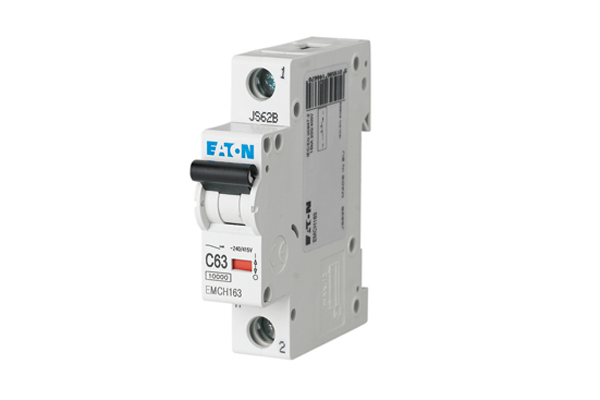Technology continues to evolve in the field of low-voltage power distribution and protection. 30 years ago the installer was typically faced with the decision on what size fuse wire to use. Now they must consider which MCB or RCBO to install, with even more choice than ever on what levels of protection against the effects of electrical fault to afford.
Released in 2018, BS 7671: Requirements for Electrical Installations (IET Wiring regulations) 18th edition references four potential types of protective device:
- MCBs – Miniature Circuit Breakers complying with BS EN 60898
- RCBOs – Residual Current Circuit Breakers with overcurrent protection complying with BS EN 61009-1
- RCCBs – Residual Current Circuit Breakers without overcurrent protection complying with BS EN 61008-1
- AFDDs – Arc Fault Detection Devices complying with BS EN 62606
In this particular article, we will look at the selection of MCBs and RCBOs and points to consider in this process.
Overcurrent Characteristics of an MCB or RCBO
The decision to use Type B, C or D MCBs or RCBOs for final circuit protection in residential, commercial or industrial buildings can be based on a few simple rules.
However, an understanding of the differences between these types of device can help the specifier or installer overcome problems of unwanted tripping, disconnections times for earth fault protection or issues associated with discrimination with upstream protective devices.
The primary purpose of circuit protection devices such as MCBs is to protect the cable downstream of the device. The first requirement, therefore, is to select a device in accordance with the latest revision of BS 7671:Requirements for Electrical Installations.
Basic applications of an MCB
The essential distinction between Type B, C or D devices is based on their ability to handle surge currents without tripping. These are, typically, inrush currents associated with reactive loads such as lighting, or loads containing motors or battery charging equipment.
Types B, C & D are recognised within BS 7671 and can be broadly categorised as follows:
- Type B devices are generally suitable for domestic applications. They may also be used in light commercial applications where switching surges are low or non-existent.
- Type C devices are the normal choice for commercial and industrial applications where some degree of electrical inrush is expected.
- Type D devices have more limited applications, normally in industrial use where high inrush currents may be expected. Examples include large battery charging systems, motors, transformers, X-ray machines and some types of lighting.
The classification of Types B, C or D is based on the fault current rating at which instantaneous operation occurs (typically less than 100ms) to protect against short-circuits. It is important that equipment having high inrush currents should not cause the circuit-breaker to trip unnecessarily, and yet the device should trip in the event of a short-circuit current that could damage the circuit cables.
Tripping characteristics:
- Type B devices are designed to trip at fault currents of 3-5 times rated current (In). For example a 10A device will trip at 30-50A.
- Type C devices are designed to trip at 5-10 times In (50-100A for a 10A device).
- Type D devices are designed to trip at 10-20 times In (100-200A for a 10A device).
Normal cable ratings relate to continuous service under specified installation conditions. Cables will, of course, carry higher currents for a short time without suffering permanent damage.
As well as protecting cables against the effects of overloads and short circuits, MCBs can also be legitimately used to provide protection against earth faults and protect against the effects of electric shock, on both fixed and portable equipment. However, the earthing arrangement and total earth loop impedance (Zs) value of the circuit will dictate whether an MCB is able to provide a suitable disconnection time.
Overcoming unwanted tripping
As well as natural inrush currents, sometimes failure of lamps/components can trip Type B circuit-breakers in domestic and retail environments. This is caused by high arcing currents occurring at the time of failure.
A Type C device may be substituted for a Type B device where unwanted tripping persists, especially in commercial applications. Alternatively it may be possible to use a higher rated Type B MCB, say 10A rather than 6A. Whichever solution is adopted, the installation must be in accordance with BS 7671.
A change from Type C to Type D devices should only be taken after careful consideration of the installation conditions, in particular the operating times required by BS7671.
Other considerations when selecting an MCB or RCBO
The importance of selecting circuit-breakers from reputable manufacturers cannot be over-emphasised. Some imported products, claiming to have a lower (typically residential) 6kA short-circuit capacity, have failed dramatically under test.
Combined overcurrent and residual current circuit breakers (RCBOs) are now commonplace in commercial buildings and growing in popularity in residential. RCBOs combine MCB and RCD technology, meaning disconnection times to protect against the effects of electric shock can typically be achieved regardless of curve type.
AFDDs in BS 7671
And finally, new for BS 7671:Requirements for Electrical Installations 18th Edition are AFDDs (Arc Fault Detection Devices). International and European wiring rules recommend the use of AFDDs for protection against arc faults, with some countries making their use mandatory. Recognised in the USA for many years and mandatory in German installation standards: AFDD devices have the potential to take UK installation safety to an even higher level, providing protection against series and parallel arcing faults which are not detectable by any of the technologies previously mentioned.
To learn more about AFDD devices please read more here.



